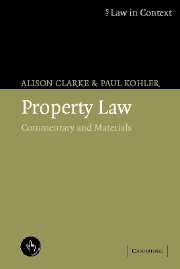Book contents
- Frontmatter
- Contents
- Preface
- Acknowledgments
- Table of cases
- Table of statutes
- Table of statutory instruments
- Table of treaties
- Table of EC legislation
- Part 1 The concept of property
- Part 2 The nature of proprietary interests
- Part 3 The acquisition and disposition of property interests
- Part 4 Proprietary relationships
- 16 Co-ownership
- 17 Leases and bailment
- 18 Security interests
- Bibliography
- Index
16 - Co-ownership
Published online by Cambridge University Press: 05 June 2012
- Frontmatter
- Contents
- Preface
- Acknowledgments
- Table of cases
- Table of statutes
- Table of statutory instruments
- Table of treaties
- Table of EC legislation
- Part 1 The concept of property
- Part 2 The nature of proprietary interests
- Part 3 The acquisition and disposition of property interests
- Part 4 Proprietary relationships
- 16 Co-ownership
- 17 Leases and bailment
- 18 Security interests
- Bibliography
- Index
Summary
Introduction
We have already seen in Chapter 8 how ownership can be fragmented in a variety of ways to form a complex matrix of interlocking interests. It can be sliced across time via the mechanism of present and future interests; split at a qualitative level into its legal and equitable components; or divided via mechanisms that from a functional perspective separate management from enjoyment. The unifying factor in all of this is that in each case ownership has been sliced in such a way as to create two (or more) interests that are conceptually and functionally quite distinct from the other. For example, an interest in possession gives its holder wholly different rights to those belonging to the remainderman despite the fact that both interests are held in respect of the same object of property. Likewise, a legal interest gives those in whom it is vested a very different interest to that enjoyed by equitable interest holders in the same thing. The directors of BP, for example (or any other plc), possess rights which are quite distinct from those held by its shareholders.
In contrast, this chapter deals not with different interests in the same thing but with shared interests. The hallmark of co-ownership is that ownership has only been split (if at all) at a quantitative, and not a qualitative, level.
- Type
- Chapter
- Information
- Property LawCommentary and Materials, pp. 571 - 608Publisher: Cambridge University PressPrint publication year: 2005

